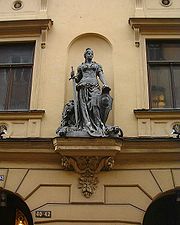
Mother Svea
Encyclopedia

Sweden
Sweden , officially the Kingdom of Sweden , is a Nordic country on the Scandinavian Peninsula in Northern Europe. Sweden borders with Norway and Finland and is connected to Denmark by a bridge-tunnel across the Öresund....
and a patriotic emblem
National emblem
A national emblem symbolically represents a nation. Most national emblems originate in the natural world, such as animals or birds, but another object may serve. National emblems may appear on many things such as the national flag, coat of arms, or other patriotic materials...
of the Swedish nation.
Background
Mother Svea is normally depicted as a powerful female warriorWoman warrior
The portrayal of women warriors in literature and popular culture is a subject of study in history, literary studies, film studies, folklore and mythology, gender studies, and cultural studies.-Archaeology:...
, valkyrie
Valkyrie
In Norse mythology, a valkyrie is one of a host of female figures who decides who dies in battle. Selecting among half of those who die in battle , the valkyries bring their chosen to the afterlife hall of the slain, Valhalla, ruled over by the god Odin...
or shieldmaiden
Shieldmaiden
A shieldmaiden was a woman who had chosen to fight as a warrior in Scandinavian folklore and mythology. They are often mentioned in sagas such as Hervarar saga and in Gesta Danorum. Shieldmaidens also appear in stories of other Germanic nations: Goths, Cimbri, and Marcomanni. The mythical Valkyries...
, frequently holding a shield and standing beside a lion. Svea
Svea
Svea is a Swedish female name. The name was a very popular girls' name during the first half of the 20th century. It may also refer to:*Mother Svea, the Swedish national emblem.*Svea, Svalbard, a mining settlement*Svea, Florida*Svea, Minnesota...
is a Swedish female personal name
Personal name
A personal name is the proper name identifying an individual person, and today usually comprises a given name bestowed at birth or at a young age plus a surname. It is nearly universal for a human to have a name; except in rare cases, for example feral children growing up in isolation, or infants...
which derives from svea, an old plural genitive form meaning "of the Swedes" or the Swea. It appears in Svea rike meaning "kingdom of the Swedes" (Swea Region), an older form of Sverige, the Swedish name for Sweden.
The popular image is considered to have been created by Swedish writer, Anders Leijonstedt (1649–1725) when first introduced in his poem Svea Lycksaligheets Triumph (1672).
As a patriotic symbol, Moder Svea gained widespread popularity in Kunga Skald (1697), written by Swedish poet Gunno Eurelius (1661–1709) in honor of King Charles XI of Sweden
Charles XI of Sweden
Charles XI also Carl, was King of Sweden from 1660 until his death, in a period in Swedish history known as the Swedish empire ....
. Eurelius was later ennobled with the name of Dahlstjerna.
Mother Svea appeared frequently as a national symbol in 19th century Swedish literature and culture. She appeared on various Swedish banknote
Swedish krona
The krona has been the currency of Sweden since 1873. Both the ISO code "SEK" and currency sign "kr" are in common use; the former precedes or follows the value, the latter usually follows it, but especially in the past, it sometimes preceded the value...
s for over seventy years, such as both the 5-kronor banknote printed between 1890–1952 and the 5-kronor banknote printed between 1954-1963.
Swedish singer Lena Philipsson
Lena Philipsson
Maria Magdalena "Lena" Philipsson is a Swedish singer and media personality.-Career:...
and composer Torgny Söderberg
Torgny Söderberg
Sten Torgny Söderberg is a Swedish songwriter. He has worked a lot together with Lena Philipsson and written schlager songs such as 100%, Kärleken är evig and Diggi-loo diggi-ley. Diggi-loo diggi-ley won the Swedish Melodifestivalen 1984 and even the Eurovision Song Contest 1984.- References :...
wrote a song entitled Moder Swea which was introduced in the 1995 album Lena Philipsson
Lena Philipsson (album)
Lena Philipsson was released on 22 November 1995 and is an album from Swedish pop singer Lena Philipsson. Lena Philipsson and Torgny Söderberg wrote the songs. The album peaked at #10 at the Swedish album chart.-Track listing:-External links:...
.
See also
- National personificationNational personificationA national personification is an anthropomorphization of a nation or its people; it can appear in both editorial cartoons and propaganda.Some early personifications in the Western world tended to be national manifestations of the majestic wisdom and war goddess Minerva/Athena, and often took the...
- Flag of SwedenFlag of SwedenThe flag of Sweden is a Scandinavian cross that extends to the edges of the flag. This Scandinavian cross represents Christianity. The design and colours of the Swedish flag are believed to have been inspired by the present Coat of arms of Sweden of 1442, which is blue divided quarterly by a cross...
- National anthem of Sweden
- Three CrownsThree CrownsThree Crowns is a national emblem of Sweden, present in the Coat of Arms of the Realm of Sweden, and composed by three yellow or gilded coronets ordered two above and one below, placed on a blue background....
Sources
- Algulin, Ingemar, and Bernt Olsson Litteraturens historia i Sverige (Stockholm, 1987)

